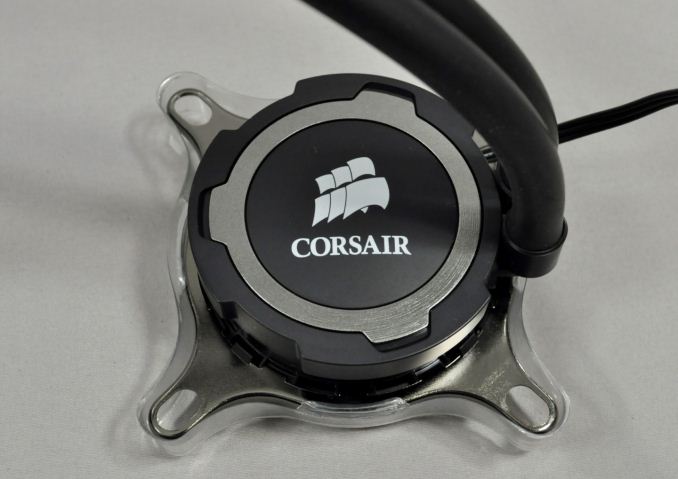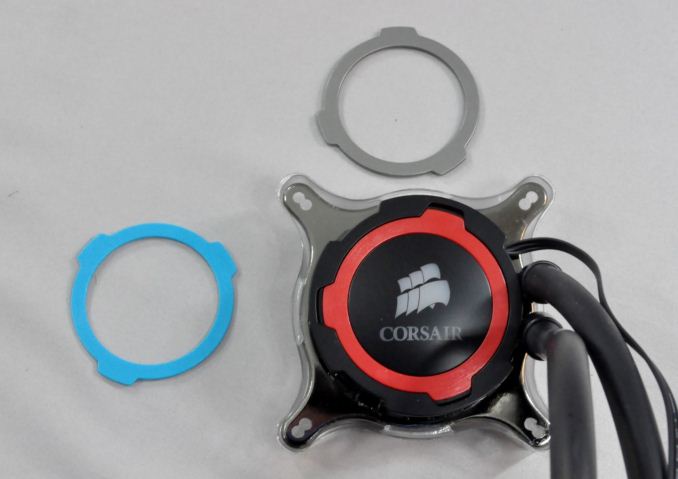Closed Loop AIO Liquid Coolers: 14-way Mega Roundup Review
by E. Fylladitakis on February 12, 2014 7:00 AM ESTCorsair
When we mentioned the word's "liquid coolers" and "roundup" to Corsair, they got a bit overexcited and shipped us five of their AIO coolers. For some reason, Corsair is extremely interested in AIO liquid coolers, which is also reflected by the fact that they are the only company that offers nine such products at this point in time, while most manufacturers are currently limited to just two or three coolers.
Corsair H75
Despite its "small" number, the H75 actually is one of Corsair's most recent designs. We received it supplied in a serious looking, black cardboard box with a blue visual theme. Inside the box, the cooler is protected by cardboard packaging.
Corsair kept the bundle of the H75 down to the very basics: a leaflet with installation instructions and the hardware required for the mounting of the cooler. The bundle is well presented though, with each type of screws/nuts inside a separate nylon bag. Two 120mm fans with grey wide blades are also included in the packaging. The fans have an operating range between 800 and 2000 RPM, which is not very high for wide-bladed 120mm fans.
The Corsair H75 is not a work of art but it does stand out visually. It features a rather small radiator that is only 120mm wide and 25mm deep, which offers no more heat dissipation surface than the radiator of the ultra-cheap Seidon 120V. Even though the radiator is of the same design, this time the aluminum fins are virtually free of imperfections, with very few slight deformations visible. The small size of the radiator gives the H75 an advantage in tight spaces but will certainly have an impact on its overall performance. Corsair also went with kink-resistant, smooth black rubber tubing of normal width, rather than the corrugated tubing many other manufacturers are using.
The block-pump assembly is round, with a silver ring on top and the company logo painted right in the middle of the cap. It also comes with the retention bracket for Intel CPUs preinstalled. The assembly is held together by no less than 20 screws, 12 for the plastic frames and 8 for the copper base. Thermal compound has been applied on the base from the factory. After our testing, we cleaned the base of the cooler, revealing a well-machined and polished surface.
Corsair H105
Announced at this year's CES, the Hydro H105 is Corsair's most recent product. It comes in a large cardboard box similar to that of the H75, yet with a red colored theme, which is the signature of Corsair's "extreme performance" products. The bundle of the H105 is almost identical to that of the H75 as well. Inside the box, we find a leaflet with the installation instructions and the necessary mounting hardware categorized inside nylon bags. However, we also found two colored rings for the CPU block. Finally, even though the wide grey bladed fans are visually similar to those included with the H75, they actually are not similar at all. The SP120L fans supplied with the H105 are much more powerful, with an operational range of 800 to 2700 RPM.
Even though the H105 looks like an oversized version of the H75, there is more to it than first meets the eye. To begin with, the radiator is not only twice as long as that of the H75 but nearly 40% thicker as well, increasing the effective heat dissipation area by well over 150%. Some minor deformations of the aluminum fins are visible this time as well; apparently, the making of such radiators is not an easy process. Although the 120mm width of the radiator makes the H105 compatible with more cases and systems, the length could become a problem, so be especially careful with that.
Similar to the H75, the block-pump assembly is round, with a silver ring on top. The silver ring however is removable and replaceable with either a red or blue ring, now included in the packaging. In addition, the company logo is not painted; on the contrary, it has been left unpainted on purpose and a white LED has been placed beneath it. The bracket for installation on Intel CPUs is once again preinstalled and the cooler has thermal compound applied on its base from the factory floor. Once again, the copper base is well machined and polished, free of imperfections.
























139 Comments
View All Comments
Dustin Sklavos - Wednesday, February 12, 2014 - link
Good lord.If I'd known my successor would produce results this thorough I'd've stepped aside a long time ago.
Really well done piece of work.
E.Fyll - Wednesday, February 12, 2014 - link
Thank you for the praise Dustin, yet I still stand unworthy of it. :)Dustin Sklavos - Wednesday, February 12, 2014 - link
I'm enjoying your work tremendously. Now that I'm at Corsair I'm glad we have someone we can send case/cooling/PSU hardware to that meets and beats the AnandTech standard.creed3020 - Wednesday, February 12, 2014 - link
Yeah Dustin....I have seriously enjoyed your labors here at AT and do miss them. Your successor has changed the paradigm so much that it's hard to compare, but it's a awesome reboot to this area of reviews here at AT.I, however, have to agree with many other commenters that a secondary dataset produced with the same 120mm/140mm fans does have it's merit as it will provide an objective evaluation of the radiator and pumps. This is one area where I am really curious to see quality differences in the products. I am fully aware that each OEM is very careful in their selection of a fan which matches their product. This is not done by lottery, that much is clear to me. The OEM behind the Silverstone/Enermax product intrigues me, as I am a fan of Silverstone products and use their cases exclusively for all of my desktops, gaming PCs, and HTPCs. The Tundra's seems like they are ripe for a revision!
BigLeagueJammer - Wednesday, February 12, 2014 - link
Under Noise Level Reference Values, your first one of <35dB(A) being "Virtually inaudible" doesn't match up with most sources I've seen. Most rate that as "very quiet" and say the limit of human hearing as 10 db(A). If other sources say things like a ticking watch is around 20 db(A) which in a quiet room is easy to hear, then 35 seems too high for your qualification of "virtually inaudible".E.Fyll - Wednesday, February 12, 2014 - link
True, I am afraid that the lot of "copy/paste-ing" online has produced a lot of bad information going around. Some are works of fiction, some are misinterpretations of confused people, some...I don't even want to know.So, copying my answer from above:
"Sub-35 dB(A) levels are generally impossible to notice by a human ear. Sub-30 dB(A) levels are next to impossible to record with anything less than science lab-grade equipment. There is no handheld or desktop dB(A) meter that can perform such readings. If you have seen reviews stating sub-30 dB(A) levels, make sure to check their methodology (given that there is any). Either the meter cannot read lower than 30 dB(A) (and/or will display a bogus reading, as most cheap Chinese meters do) and the review is a fictional text or their methodology is based on dB readings, not dB(A) readings, which is useless to a consumer."
I think it will suffice for me to say that you cannot possibly hear what an instrument designed for this specific purpose cannot even record. In theory, the human hearing threshold is 1 dB(A); in practice however, that is true only for specific frequencies. The background noise of a typical room is almost always above 32-33dB(A).
Jon-R - Wednesday, February 12, 2014 - link
What is your opinion on the tests done over at SilentPCReview? They test using lab-grade equipment. A rundown can be found here: http://www.silentpcreview.com/article875-page2.htm...They use reference fans which measure around 13dBA at their slowest fan speeds, and they don't think highly of AIO water-cooling at all, as none of the tested ones have come close to the best air-coolers when it comes to quiet cooling.
E.Fyll - Wednesday, February 12, 2014 - link
From what I can see, they are using a highly sensitive microphone and a computer's sound card to record the results, connected through an amplifier. Although the equipment is very good, this is not "lab grade equipment" but just a customized setup. A very good setup nonetheless, including an anechoic chamber. They have a microphone with a self-noise of 8 dB, which measures 11 dB(A) inside the aforementioned anechoic chamber.It will suffice to say that their results are just in no way comparable to mine. Actually, as noise level measurements are environment-specific, you should only compare the results of a same setup, never in-between different setups. Unless they are all science labs with multiple ISO certifications, of course. Given that my room floor noise level is over 30 dB(A) and they are using a sub-12 dB(A) anechoic chamber, I believe that I do not have to stress how different the results out of these two setups are.
As far as equipment goes, for example, this is a cheap lab grade sound analyzer and still costs 5 times more than the whole setup that you showed me, microphones and secondary equipment aside:
http://www.nti-audio.com/en/products/flexus-fx100....
Jon-R - Wednesday, February 12, 2014 - link
But you're not saying that their measurements are inaccurate, only that they've got a significantly lower noise-floor than what you're using? So it boils down to the difference between what is considered silent? Because 30dBA is louder than their reference fan it its loudest setting, and far beyond what they consider acceptable. Just as a reference, they measured 43 dBA for the Silverstonde TD03 at 12v, and 30 dBA at 7v.E.Fyll - Wednesday, February 12, 2014 - link
"Inaccurate" is a harsh word when it comes to sound pressure level measurements. Although I would not hesitate to use this word for most other types of tests, there are far too many variables at stake here. I believe that their setup may be better than mine. I am just using a good handheld sound level meter, with the product positioned in the middle of a standard room.I would simply stick with "different".
Sound levels are additive. If you have a noise source of 20 dB(A) and added another source of 20 dB(A), the room noise would not be 20 dB(A) but 23 dB(A). A third source would make it 24.8 dB(A) and so on. So, a fan that would measure 18 dB(A) inside an 12 dB(A) anechoic chamber, will still add to the 30.4 dB(A) floor noise of my room. The difference is the magnitude, as the scale is logarithmic. As you said, the TD03 added about 18 dB(A) and 30 dB(A) to their setup, when it adds 8.3 dB(A) and 17.7 dB(A) to mine, because of the higher background noise. These differences are in no way comparable to each other; that is only possible when the scale is linear. The further you move up the decibel scale, the largest the increase of SPL becomes per single decibel.